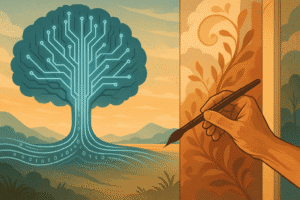The relentless drumbeat of AI innovation isn’t just changing advertising; it’s demanding a fundamental rewiring of the industry’s mindset. At Campaign India’s recent “Cannes Homecoming” panel, powered by Truecaller, India’s top creative and tech strategists grappled with this pivotal question: In a world obsessed with data-driven efficiency, how do we ensure technology amplifies empathy, not erases it?
The consensus was clear: We stand at a precipice. As Vanita Rathore (Truecaller) emphatically stated, the entire ecosystem – advertisers, agencies, publishers – needs a shift. It’s no longer about choosing between speed, scale, precision, or purpose. The future belongs to those who integrate them all, harnessing AI’s power while fiercely protecting the irreplaceable spark of human connection.
AI: The Creative Catalyst, Not the Creator
Gone are the days when tech was merely a support function. As Rathore highlighted, it’s now woven into the creative fabric itself. But this integration demands vigilance:
- Meaning Over Mass: “AI can churn out 100 messages, but can it deliver the right meaning?” Rathore asked. True success lies in the synchronization of algorithmic power and human intuition. Campaigns lose their soul when generated “on the fly” without cohesive brand voice.
- Beyond the Clickbait Trap: Vishal Sagar (PocketFM) acknowledged the pressure to chase trends but issued a warning: “Trends will come and go, but brands must outlast them. We are not for the trend; we are for the brand.” Courage and trust between client and agency are vital to champion meaningful, tech-enabled work over superficial virality.
- Experimentation is Key: Niraj Ruparel (WPP) championed agility. Spotting trends early and building momentum, even with lean budgets, prepares clients for calculated risks. He cited innovations like Perfetti’s voice-AI for feature phones in rural India and Britannia’s inclusive retail experiences as proof of purpose-driven tech.
The Non-Negotiable: Guarding Privacy and Trust
Embedding technology demands an equally embedded ethical compass:
- Privacy as Priority: Rathore was unequivocal: “Creative professionals must ensure that their ideas not only inspire but also respect data boundaries.” Scaling campaigns globally means navigating diverse regulations; consent, transparency, and trust are non-negotiable. “We have to be privacy-first.”
- The Data Dilemma: Sagar pointed to the core tension in the AI ecosystem. While engineers and infrastructure command high investment, the crucial fuel – data – is often scraped freely, raising ethical concerns (like the Studio Ghibli replication controversy). The industry needs robust guardrails.
- Patience for Responsibility: Jayesh Pandey (Accenture Song) offered historical perspective. Major innovations, from railroads to data mining, have historically outpaced regulation. AI is no different. While advocating for responsible development, he expressed confidence that ethical frameworks will catch up, urging patience and proactive responsibility in the interim.
Reclaiming Creative Value: The Human Edge in the Machine Age
Amidst the disruption, Pandey sees a profound opportunity: “AI has disrupted the non-creative parts of the value chain so dramatically that it frees up space, both time and budget, for real creativity.” The rallying cry? “Let the efficiency dollars flow back into creativity.”
This is where creatives hold an unassailable advantage:
- The Emotional Imperative: Pandey brought it back to the core: “Is my message moving someone? Does it impact human choice or emotion?” Technology offers granular behavioral insights, but translating that into resonant messaging requires emotional intelligence – a uniquely human skill.
- Leaning into Humanness: “No one else is better positioned to bring that emotional intelligence to the table,” Pandey asserted. The opportunity isn’t to mimic AI’s efficiency but to amplify what it lacks: curiosity, courage, empathy, and the daring to take chances based on human understanding (Sagar).
- Redefining Roles: Pandey outlined the future:
- Human-in-the-Loop: Outsourcing repetitive tasks to AI, freeing humans to focus on emotion, originality, and judgment.
- Human-on-the-Loop: Guiding and evaluating AI outputs as strategic decision-makers.
- Out-of-the-Loop: Those who resist adaptation, facing irrelevance.
Building the Future: Synergy, Systems, and Prototypes
The path forward requires structural change:
- Synergy Over Replacement: Rathore stressed AI must empower, not replace. It’s about “giving deeper meaning to messaging, not just faster output.” This requires integrating tech, creativity, and purpose into the foundations of teams and processes.
- Breaking Silos: Pandey emphasized that unlocking AI’s potential means dismantling departmental barriers. Create measurable systems that free creatives to be unpredictable, emotional, and intuitive – things only humans can do.
- Operationalizing AI: Sagar pointed to Alibaba’s Singles Day (AI generating banners equivalent to 150 art directors working for 100 years) as a model. Outsource the repeatable to reclaim time for the meaningful. View AI as “an intern who gives you 100 rough ideas” – a powerful head start, not a threat.
- Prototype or Perish: Ruparel issued a crucial call to the next generation: “Don’t pitch ideas, build prototypes.” Clients demand tangible, locally relevant solutions, not imported concepts. “AI shouldn’t just be smart; it should be accessible. Show them the money, not just the muscle.”
The Takeaway: The Calculus of Creativity Evolves
The message from Cannes Homecoming is resounding. AI is the new creative calculus, but the equation only balances when human insight provides the essential variables: empathy, ethics, courage, and emotional resonance. Technology offers unprecedented speed and scale, but the future of impactful advertising belongs to those who wield it not as a replacement for humanity, but as its most powerful amplifier. The winners will be those who master the art of making algorithms feel human, ensuring that in the age of data, the heart of the story never gets lost.

You must be logged in to post a comment.